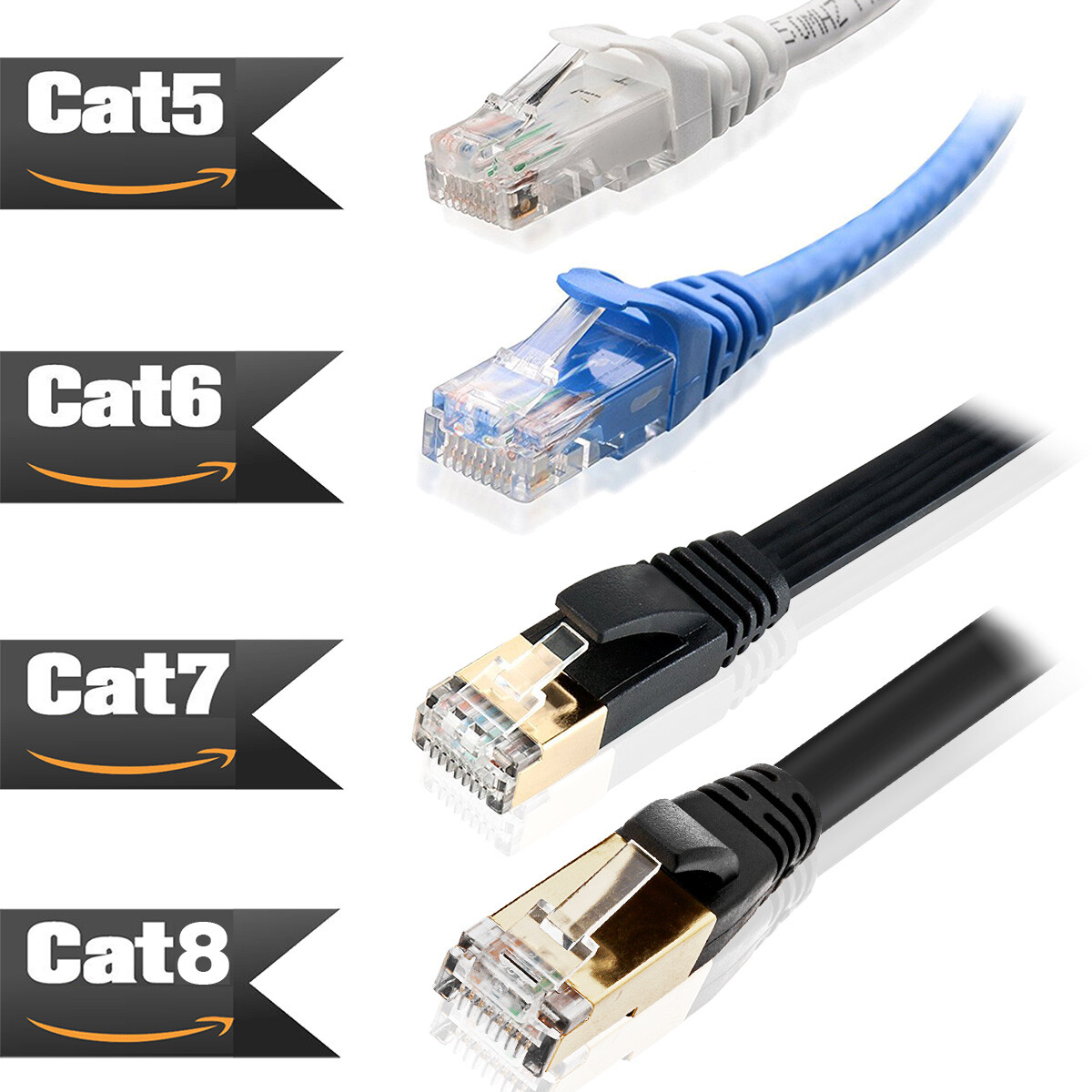For most home and office networks, a Cat7 cable is overkill. Cat6A provides the same 10 Gbps speed at a lower cost and is the recognized TIA standard.

Table of Contents
- What Exactly is a Cat7 Cable?
- How Does Cat7 Compare to Other Ethernet Cables?
- When is Cat7 Considered Overkill?
- Are There Scenarios Where Cat7 Makes Sense?
- The Verdict: Should You Buy a Cat7 Cable?
What Exactly is a Cat7 Cable?
Category 7 (Cat7) cable represents a significant leap in Ethernet technology, designed for high-speed, high-bandwidth applications. Understanding its specific characteristics is key to determining if it’s the right fit for your needs or an unnecessary expense. Unlike its predecessors, Cat7 was engineered to support the demanding requirements of future data centers and enterprise-level networking.
Decoding the Specifications: Speed and Frequency
At its core, a Cat7 cable is designed to deliver 10 Gigabit Ethernet (10 Gbps) over 100 meters (328 feet) of copper cabling. This speed matches that of Cat6A, but the primary differentiator is its bandwidth frequency. Cat7 supports a transmission frequency of up to 600 MHz, a notable increase over Cat6A’s 500 MHz and Cat6’s 250 MHz. This higher frequency allows for more data to be transmitted simultaneously and provides better resistance to noise and crosstalk, which can degrade signal quality.
This enhanced performance is achieved through stricter construction standards. Every Cat7 cable is required to have extensive shielding, both for individual wire pairs and for the cable as a whole. This construction is known as Screened/Foiled Twisted Pair (S/FTP), which makes the cable thicker, more rigid, and more effective at mitigating interference.
The Standards Dilemma: TIA vs. ISO
One of the most critical and often misunderstood aspects of Cat7 is its standardization. While it is recognized by the International Organization for Standardization (ISO) and the International Electrotechnical Commission (IEC) under the ISO/IEC 11801 standard, it is not officially recognized by the Telecommunications Industry Association (TIA) or Electronic Industries Alliance (EIA). The TIA/EIA are the primary standards bodies for networking cables in North America.
Instead of Cat7, the TIA/EIA-approved standard for 10 Gbps networking is Cat6A. This lack of TIA recognition means that Cat7 is not the recommended standard for commercial installations in many regions. This is a crucial factor for businesses and professional installers to consider when planning network infrastructure.
A Note on Connectors: RJ45 vs. GG45/TERA
To fully leverage the 600 MHz frequency and performance potential, the official ISO/IEC standard for Cat7 specifies the use of advanced connectors like GG45 or TERA, not the ubiquitous 8P8C (RJ45) connector used with Cat6 and Cat6A. However, the vast majority of “Cat7” patch cords sold on the market are terminated with standard RJ45 connectors to ensure backward compatibility with existing network hardware like routers, switches, and computers.
When a Cat7 cable uses an RJ45 connector, its performance is effectively limited to that of a Cat6A cable. While you still benefit from the superior shielding of the Cat7-rated cable, you are not accessing its full theoretical potential. This makes most commercially available Cat7 cables function as very well-shielded Cat6A cables.
How Does Cat7 Compare to Other Ethernet Cables?
Choosing the right Ethernet cable involves comparing specifications, performance capabilities, and cost. While Cat7 offers impressive on-paper specs, its practical advantages diminish when compared directly with its closest relatives, Cat6A and the newer Cat8.
Cat7 vs. Cat6: A Clear Step Up in Performance
The comparison between Cat7 and Cat6 is straightforward. Cat6 supports 1 Gbps up to 100 meters and 10 Gbps only up to about 55 meters under ideal conditions. It also operates at a lower frequency of 250 MHz. Cat7, with its 10 Gbps speed over 100 meters and 600 MHz frequency, is objectively superior. Furthermore, Cat7’s mandatory S/FTP shielding offers far better protection against electromagnetic interference (EMI) and crosstalk than the optional shielding of Cat6 cables.
Cat7 vs. Cat6A: The Real Contender
This is the most relevant comparison for most users. Cat6A (Category 6 Augmented) is the TIA/EIA standard for 10 Gbps over 100 meters. It operates at 500 MHz, just shy of Cat7’s 600 MHz. For nearly all home and business applications, this difference in frequency is negligible and provides no discernible real-world performance benefit.
Since both cables deliver the same maximum speed and distance, and most network equipment tops out at 10 Gbps, Cat6A provides identical performance for a lower cost. It is also a more flexible and easier-to-install cable, as its shielding requirements are less stringent than Cat7’s. Because Cat6A is an official TIA/EIA standard, it is the preferred choice for structured cabling and professional installations.
Cat7 vs. Cat8: A Glimpse into the Future
Cat8 is the true successor for next-generation network speeds. It is a TIA/EIA-recognized standard designed for data centers and other high-demand environments. Cat8 supports speeds of 25 Gbps or even 40 Gbps but over a much shorter distance of 30 meters (about 100 feet). It operates at a massive 2000 MHz frequency. Cat7 is completely outmatched by Cat8 in terms of raw speed, making Cat8 the only viable choice for those who need to move beyond 10 Gbps.
| Feature | Cat6 | Cat6A | Cat7 | Cat8 |
|---|---|---|---|---|
| Max Speed | 10 Gbps (up to 55m) | 10 Gbps | 10 Gbps | 40 Gbps |
| Max Distance | 100m (at 1 Gbps) | 100m | 100m | 30m |
| Frequency | 250 MHz | 500 MHz | 600 MHz | 2000 MHz |
| TIA/EIA Standard | Yes | Yes | No | Yes |
| Common Use | Home/Office LAN | 10G Networks | Heavily Shielded 10G | Data Centers |
When is Cat7 Considered Overkill?
For a vast majority of network applications, deploying Cat7 cables is an unnecessary expenditure of money and effort. The existing infrastructure and typical user needs simply do not require the marginal benefits it offers over the more practical Cat6A standard.
For Home Networking and Streaming
The average home internet connection in the United States is well below 1 Gbps. Even with a top-tier fiber optic plan, you are unlikely to exceed 1-2 Gbps. A Cat6 cable can easily handle these speeds. For streaming 4K or even 8K video, which requires about 25-100 Mbps, both Cat6 and Cat6A are more than sufficient. Using a Cat7 cable for connecting your TV, streaming box, or computer to your router will yield no improvement in streaming quality or buffering over a properly installed Cat6A or even a Cat6 cable.
For Online Gaming
A common misconception is that a higher-category cable will reduce latency or “ping” in online games. Latency is primarily determined by the distance to the game server and the efficiency of your Internet Service Provider’s network, not the data capacity of your local Ethernet cable. Gaming uses a very small amount of bandwidth, often less than 1 Mbps. The key for gaming is a stable, consistent connection, which any well-constructed Cat6 or Cat6A cable can provide. A Cat7 cable offers no competitive advantage for gamers.
For Standard Office Environments
Most office networks are built around a 1 Gbps infrastructure for individual workstations. Even in environments moving to 10 Gbps desktops, Cat6A is the industry-standard choice. It is fully certified by the TIA/EIA, is more cost-effective, and is easier for installers to work with than the thicker, more rigid Cat7 cable. For new builds and upgrades, network professionals consistently choose Cat6A for its balance of performance, cost, and adherence to established standards.
Are There Scenarios Where Cat7 Makes Sense?
Despite being overkill for most, there are specific niche situations where the unique characteristics of a Cat7 cable—or rather, a commercially available Cat7 cable with RJ45 ends—could be beneficial. These situations almost always revolve around its exceptional shielding.
Extreme Electrical Interference
The primary real-world benefit of a Cat7 cable is its S/FTP construction. If you need to run an Ethernet cable in an environment with high levels of electromagnetic interference (EMI), Cat7’s robust shielding can be a major asset. This includes running cables parallel to high-voltage power lines, near large motors, fluorescent lighting ballasts, or in industrial settings. In these electrically “noisy” environments, the shielding helps protect the data signal from corruption, ensuring a stable connection where a lesser-shielded cable like UTP Cat6 might fail.
The “Future-Proofing” Argument
Some users purchase Cat7 with the idea of “future-proofing” their network. The logic is that by installing a cable with higher specifications today, they will be ready for tomorrow’s faster network technologies. However, this argument is flawed. The next step beyond 10 Gbps is 25/40 Gbps, which is standardized with Cat8 cabling. Cat7 will never support these speeds. Therefore, for genuine future-proofing against next-generation speeds, Cat8 is the only logical choice. For the entire 10 Gbps generation, Cat6A remains the official and sufficient standard.
Leveraging Superior Shielding
Ultimately, the best reason to choose a Cat7 cable today is if you want the absolute best shielding available for a 10 Gbps connection. While a shielded Cat6A cable (F/UTP or S/FTP) also offers excellent protection, Cat7’s design specifications mandate the highest level of shielding. If your primary concern is signal integrity in a challenging environment, and the higher cost and rigidity are not deterrents, a high-quality Cat7 cable can provide peace of mind.
The Verdict: Should You Buy a Cat7 Cable?
After weighing the technical specifications, industry standards, and practical use cases, a clear picture emerges. The decision to purchase a Cat7 cable should be based on a realistic assessment of your networking needs rather than a pursuit of the highest number on the box.
The Practical Choice: Why Cat6A Often Wins
For over 99% of users, from homeowners and gamers to small and large businesses, Cat6A is the smarter choice. It delivers the exact same 10 Gbps speed over the same 100-meter distance as Cat7. It is an official TIA/EIA standard, ensuring compatibility and performance benchmarks. It is also more affordable, more flexible, and easier to install. Cat6A hits the sweet spot of performance, price, and practicality for all current mainstream networking needs.
Making an Informed Decision for Your Network
A Cat7 cable is not a bad product; it is simply a specialized one whose primary benefit—superior shielding—is only necessary in a handful of situations. If you are running cables through an area with significant EMI, Cat7 is a justifiable option. For everyone else, your money is better spent on a high-quality, well-constructed Cat6A cable.
Whether you decide that a robust Cat6A is your best bet or you opt for the enhanced shielding of a Cat7 cable, sourcing from a reputable supplier is paramount. High-quality cables, such as those from DLA YCABLE, use pure copper conductors and undergo rigorous Fluke testing to ensure you receive the certified performance you pay for, regardless of the category. Investing in a properly manufactured cable is the best way to guarantee a stable and reliable network for years to come.

